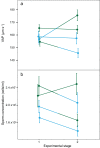Sperm competition risk drives rapid ejaculate adjustments mediated by seminal fluid
- PMID: 29084621
- PMCID: PMC5669631
- DOI: 10.7554/eLife.28811
Sperm competition risk drives rapid ejaculate adjustments mediated by seminal fluid
Abstract
In many species, males can make rapid adjustments to ejaculate performance in response to sperm competition risk; however, the mechanisms behind these changes are not understood. Here, we manipulate male social status in an externally fertilising fish, chinook salmon (Oncorhynchus tshawytscha), and find that in less than 48 hr, males can upregulate sperm velocity when faced with an increased risk of sperm competition. Using a series of in vitro sperm manipulation and competition experiments, we show that rapid changes in sperm velocity are mediated by seminal fluid and the effect of seminal fluid on sperm velocity directly impacts paternity share and therefore reproductive success. These combined findings, completely consistent with sperm competition theory, provide unequivocal evidence that sperm competition risk drives plastic adjustment of ejaculate quality, that seminal fluid harbours the mechanism for the rapid adjustment of sperm velocity and that fitness benefits accrue to males from such adjustment.
Keywords: Oncorhynchus tshawytscha; ejaculate quality; evolutionary biology; genomics; seminal fluid; social status; sperm competition; sperm velocity.
Conflict of interest statement
No competing interests declared.
Figures








Comment in
-
The need for speed.Elife. 2017 Oct 31;6:e32009. doi: 10.7554/eLife.32009. Elife. 2017. PMID: 29084622 Free PMC article.
References
-
- Bailey J, Alanäuräu A, Bräunnäus E. Methods for assessing social status in Arctic charr. Journal of Fish Biology. 2000;57:258–261. doi: 10.1111/j.1095-8649.2000.tb00792.x. - DOI
-
- Bates D, Mächler M, Bolker B, Walker S. Fitting linear mixed-effects models using lme4. Journal of Statistical Software. 2015;67:1–48. doi: 10.18637/jss.v067.i01. - DOI
-
- Bencic DC, Krisfalusi M, Cloud JG, Ingermann RL. Maintenance of steelhead trout (Oncorhynchus Mykiss) sperm at different in vitro oxygen tensions alters ATP levels and cell functional characteristics. Fish Physiology and Biochemistry. 1999;21:193–200. doi: 10.1023/A:1007880426488. - DOI
-
- Berejikian BA, Van Doornik DM, Endicott RC, Hoffnagle TL, Tezak EP, Moore ME, Atkins J. Mating success of alternative male phenotypes and evidence for frequency-dependent selection in Chinook salmon, Oncorhynchus tshawytscha. Canadian Journal of Fisheries and Aquatic Sciences. 2010;67:1933–1941. doi: 10.1139/F10-112. - DOI
Publication types
MeSH terms
LinkOut - more resources
Full Text Sources
Other Literature Sources

